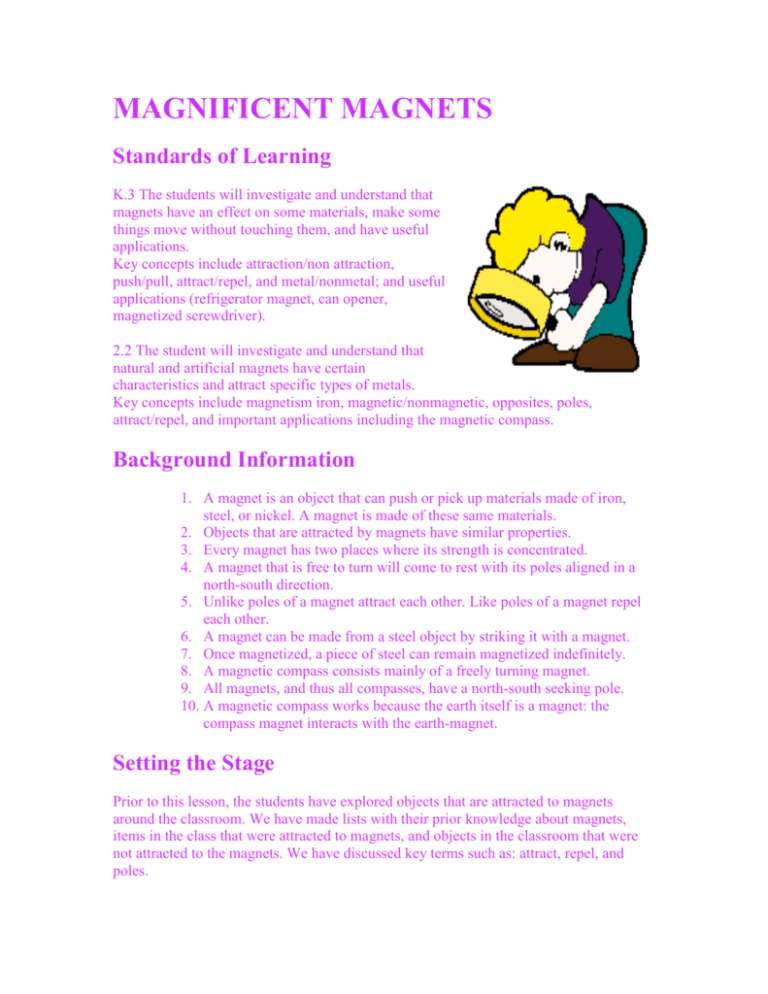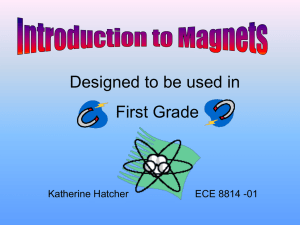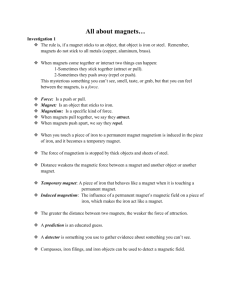Magnificent Magnets Lesson Plans
advertisement

MAGNIFICENT MAGNETS Standards of Learning K.3 The students will investigate and understand that magnets have an effect on some materials, make some things move without touching them, and have useful applications. Key concepts include attraction/non attraction, push/pull, attract/repel, and metal/nonmetal; and useful applications (refrigerator magnet, can opener, magnetized screwdriver). 2.2 The student will investigate and understand that natural and artificial magnets have certain characteristics and attract specific types of metals. Key concepts include magnetism iron, magnetic/nonmagnetic, opposites, poles, attract/repel, and important applications including the magnetic compass. Background Information 1. A magnet is an object that can push or pick up materials made of iron, steel, or nickel. A magnet is made of these same materials. 2. Objects that are attracted by magnets have similar properties. 3. Every magnet has two places where its strength is concentrated. 4. A magnet that is free to turn will come to rest with its poles aligned in a north-south direction. 5. Unlike poles of a magnet attract each other. Like poles of a magnet repel each other. 6. A magnet can be made from a steel object by striking it with a magnet. 7. Once magnetized, a piece of steel can remain magnetized indefinitely. 8. A magnetic compass consists mainly of a freely turning magnet. 9. All magnets, and thus all compasses, have a north-south seeking pole. 10. A magnetic compass works because the earth itself is a magnet: the compass magnet interacts with the earth-magnet. Setting the Stage Prior to this lesson, the students have explored objects that are attracted to magnets around the classroom. We have made lists with their prior knowledge about magnets, items in the class that were attracted to magnets, and objects in the classroom that were not attracted to the magnets. We have discussed key terms such as: attract, repel, and poles. Activity: Exploring A Magnet's Strength Concept: Magnets can be a variety of sizes, shapes, and strengths. Objective: The student will investigate and understand that magnets can be a variety of sizes, shapes, and strengths. Materials: * bar magnets * circular magnets * horseshoe magnets * regular refrigerator magnet * paper clips * sheets of loose leaf paper * pieces of cloth * pieces of wax paper * pieces of aluminum foil * chart developed by teacher * pencil to record data Instructions: 1. Dicuss the background information at the beginning of the lesson with the students. Talk about what the students will be exploring during this lesson. Divide the students into small groups. (Approximately 3 to 4 students per group.)Pass out a small box of paper clips and one of each kind of magnet to each group. Before beginning the activity have the students listen carefully to instructions. 2. On the worksheet provided, have each student predict how many paper clips each magnet will pick up. 3. After making their predictions, have each group put their paper clips in a pile. One magnet at a time, hold the magnet over the pile of paper clips to see how many will be attracted. 4. Once the magnet has picked up the paper clips, move the magnet away from the pile and pull each paper clip off the magnet as you them. Record the number of paper clips it lifted in the chart under the appropriate magnet. 5. Once each group has repeated this with each magnet, discuss/compare the results each group had as a class. Which magnet picked up the least amount of paper clips? Which magnet picked up the most paper clips? Which magnet is the strongest? Which magnet was the weakest? Was the biggest magnet the strongest? 6. Pass out the remaining supplies. 7. Allow the students to explore to discover through what materials their magnets will still pick up paper clips. Try every material with each magnet. Record the number of paper clips the magnet picked up wrapped in the different materials. 8. Discuss the students' findings. Did the magnet still work through the various materials? Did the number of paper clips the magnet picked up change? If so, by how many for each material? Extensions Have each group graph the data they collected. Present the graph and their findings to the class. Have students bring in refrigerator magnets from home. Test the magnets by picking up paper clips to see who has the strongest magnet. Put a paper clip in an empty glass jar. Use a magnet to move the paper clip around in the jar. Fill the jar with water. What will happen now? Explore moving paper clips around on the tops of the desks using different magnets. Will all of the magnets work through the desk? Look for books on magnets in the library. Have each student find at least one fact about magnets and present that fact to the class. Evaluation Pre-Test 1. A magnet will pick up a _______________. A. paper clip B. piece of wood C. piece of chalk D. shoe 2. Magnets should not be put near _____________. A. desks B. books C. computers D. pencils 3. The two ends of a bar magnet are called the ______. A. rods B. poles C. backs D. ends 4. Like poles __________. A. attract B. repel C. do nothing D. stick together 5. You can find a magnet in _____________. A. a rocking chair B. a pencil C. a picture D. an electric can opener Post-Test 1. The magnet that picked up the most paper clips (the strongest)was ______________. A. the bar magnet B. the horseshoe magnet C. the circle magnet D. the piece of wood 2. A magnet is the strongest _____________. A. in the middle B. all over C. at the poles D. on the front 3. If you wrap a magnet in cloth, the magnet will __________. A. repel the paper clips B. become warm C. attract paper clips D. become cold 4. The weaker magnet picks up ______________. A. the most paper clips B. the least paper clips C. 100 paper clips D. pencils 5. If you put the North and South poles together the magnets will __________. A. repel B. freeze C. start to smoke D. attract References Magnets http://www.coreknowledge.org/CKproto2/resrcs/lessons/298AmazingMags.htm This site is an entire unit on magnets. It contains 11 lesson plans that are great for elementary teachers. All of these lessons use simple materials that are easily found in any classroom. Magnets http://www.coreknowledge.org/CKproto2/resrcs/lessons/298Magnetism.htm This is a three-week unit designed to give students experiences with magnets and magnetism. Students will examine the interaction of matter with the energy stored in magnetic fields. The students begin by investigating the effects of magnets on familiar magnetic and nonmagnetic materials. The exploration continues to consider the effects of the earth's magnetic field on freely suspended materials. Students will learn about the Earth's magnetic field and how this relates to a compass. Core Unit: Magnets http://www.sasked.gov.sk.ca/docs/elemsci/gr2ubesc.html In this unit students perform a variety of activities to learn about magnets. They determine the kinds of objects which are attracted to a magnet. Other related experiences allow students to discover that there are two poles on a magnet, and that those poles have either attractive or repulsive effects on the pole of a second magnet. Magnets http://www.uen.org/utahlink/lp_res/TRB031.html This site from the Utah State Office of Education provides background information on magnets and lesson plans for seven student activities. Throughout the unit students will determine the effects of magnets on objects in the environment. Bill Nye - Magnetism http://nyelabs.kcts.org/teach/episodeguides/eg21.html This site is an online guide to the Bill Nye The Science Guy episode on magnetism. Included are descriptions of magnetism, some fast facts, and book ideas for teachers. VanCleave's, Janice, Magnets: Mind-boggling Experiments You can Turn Into Science Fair Projects, John Wiley & Sons, Inc. New York, 1993. This book contains a lot of hands on experiences elementary students can do to learn and experiment with magnets. All of the directions are very easy to follow and there are also extensions with each experiment.







